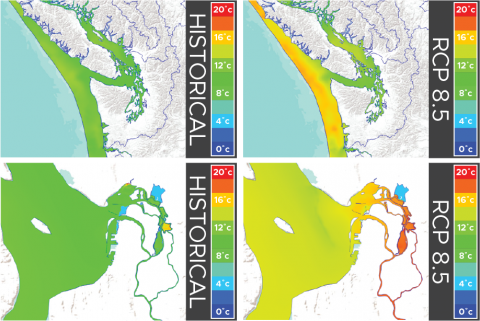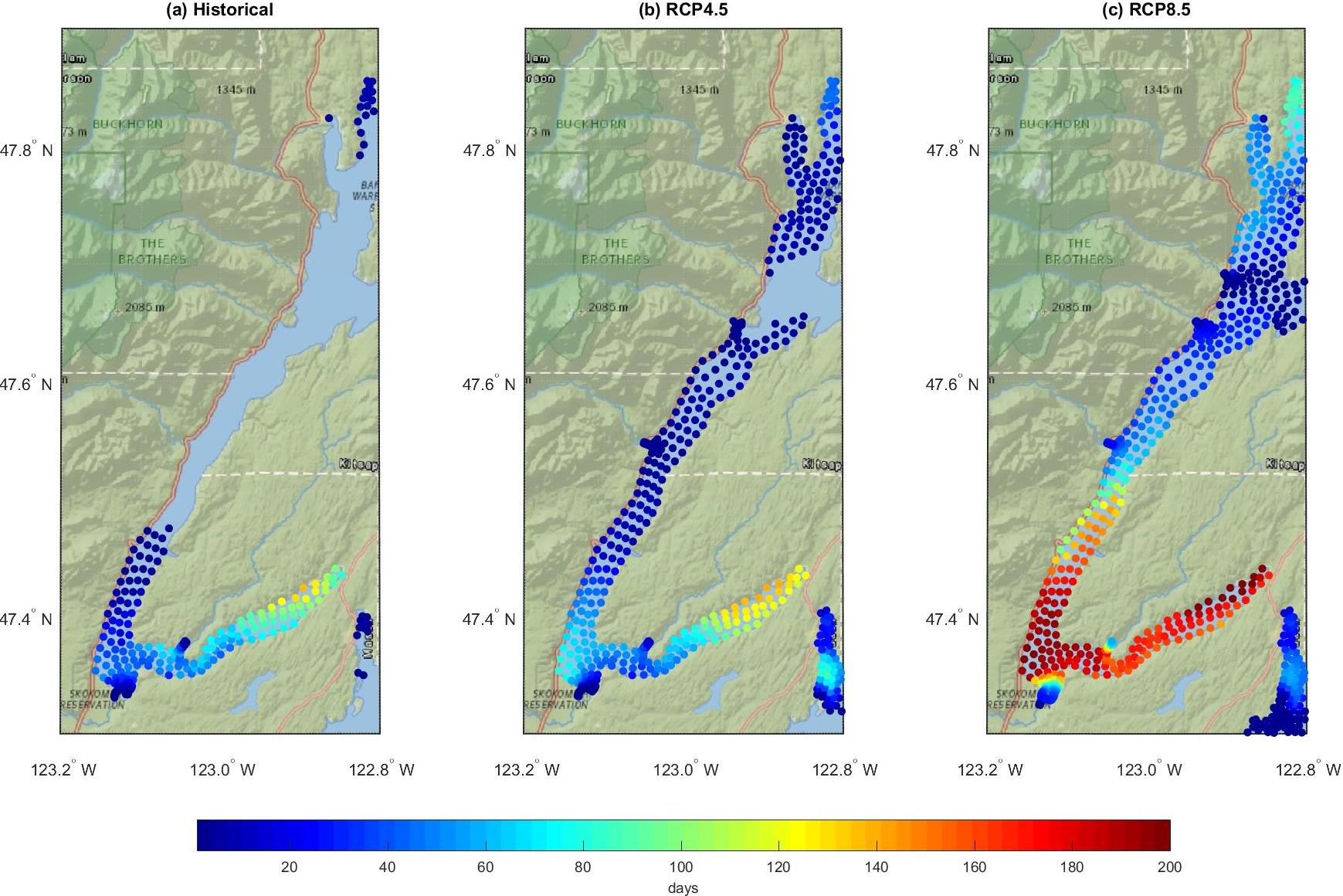SSM Water Quality: Climate Change
Simulation of Response to Climate Change and Sea Level Rise Scenarios - Salish Sea Model

There is much interest in understanding the impacts of climate change on nearshore riverine or estuarine scales. Responses such as changes to stratification, circulation, and water quality may vary based on site-specific conditions. In the absence of information on local hydrodynamic and environmental characteristics, community-wide uncertainty about the magnitude of potential future impacts often hinders efforts to plan and implement adaptive management measures.
This project supports a joint effort between the Climate Preparedness and Resilience Program, U.S. Army Corps of Engineers (U.S. ACE) and U.S. Environmental Protection Agency (U.S. EPA) requiring application of the Salish Sea Model to assess projected future climate impacts in the estuarine environment of Puget Sound on a smaller, sub-basin scale. U.S. ACE and the U.S EPA are seeking to understand better the nexus of mitigation and adaptation initiatives within their overall climate-change programs.

Overall objective of this effort project is to provide U.S. ACE, U.S. EPA, and their partners with new and valuable insights on how mitigation and adaptation initiatives in finer-scale estuarine/nearshore environments may be impacted by climate change. The project is serves as a proof-of-concept effort to develop procedures and methods to downscale global scale CESM data products to drive nearshore estuarine simulations.
The specific objectives of this effort are to:
- Functionally link downscaled climate-change models (i.e., meteorology, open ocean chemistry, and hydrology) for the Pacific Northwest to the marine circulation and water-quality model that has been developed for the Salish Sea.
- Identify, Evaluate, and Import Climate-Change, Hydrological, and Meteorological Model Simulations for use downscaled for the Pacific Northwest as Inputs to the Salish Sea Model.
- Profile the projected interaction of riverine and marine systems at the estuarine/nearshore interface for selected locations, scenarios, and variables.
Project Highlights
PNNL used an ensemble-mean from Community Earth System Model (CESM)'s Large Ensemble Community Project (Kay et al. 2015 ) downscaled to Pacific Northwest to generate historical and future simulated inputs for the Salish Sea Model. River flow and temperature were obtained from MOSART model predictions and meteorological inputs from the WRF based RESM model. The historical scenario was defined as the average of CESM model predictions for years 1995-2004 and the future scenario was defined as CESM model average of RCP 8.5 scenario for years 2091-2100. Project highlights are as follows:
) downscaled to Pacific Northwest to generate historical and future simulated inputs for the Salish Sea Model. River flow and temperature were obtained from MOSART model predictions and meteorological inputs from the WRF based RESM model. The historical scenario was defined as the average of CESM model predictions for years 1995-2004 and the future scenario was defined as CESM model average of RCP 8.5 scenario for years 2091-2100. Project highlights are as follows:
- Salish Sea-wide warming is predicted in the future. Annual mean water temperature inside the Salish Sea is predicted to increase by 1.77°C in the future Y2095 RCP8.5 scenario. The warming, especially at estuaries and inner bays, are likely to increase exposure to high temperatures indicating potential for increased thermal stress for the ecosystem.
- Maximum area of near-bed hypoxia (DO <2mg/L) is predicted to occupy as much as 16% of the Salish Sea and the majority of Hood Canal in the future Y2095 RCP8.5 scenario. Annual mean Salish Sea-wide DO is predicted to decrease by 0.7 mg/L.
- Model simulations predict that higher temperatures in the future have the potential to cause algal species shifts. Based on the simple kinetics in the model, dinoflagellates were favored (increase by 196%) and diatoms were hindered (decrease by 14%). The overall annual mean algal biomass is predicted to increase by 23% in the RCP8.5 simulation relative to historical levels as a result of higher temperatures and higher nutrient loads.
- A 9% higher concentration of nitrates in the tidally averaged estuarine inflow from the Pacific Ocean, 44% increase in nitrate loads from rivers, and near doubling of wastewater inflows is estimated for future Y2095 RCP8.5 scenario.
- Ocean acidification effects propagate with a Salish Sea-wide mean pH reduction of 0.12 units predicted in the future Y2095 RCP8.5 simulation relative to historical levels.
- The temperature increase, DO depletion, and pH reduction levels listed above are domain-wide averages that are considerably muted relative to levels at the ocean boundaries and inflows. The strong vertical circulation and mixing with the Salish Sea and biogeochemical activity in the inner Salish Sea sub-basins provide a buffering effect reducing the impacts from global temperature increase, DO depletion, and acidification.
- The intertidal reaches of the Snohomish River estuary, an inner Salish Sea sub-basin, is predicted to experience up to 3°C annual mean surface temperature increase based on RCP8.5 simulation. The projected temperature-increase in the estuary relative to historical conditions is dominated by the temperature increase from Snohomish River inflow over the delta.
- As a result of sea level rise, seawater intrusion frequency and distance are predicted to increase. In the future Y2095 RCP8.5 scenario, salinity intrusion is predicted to extend as far upstream as RKM 18 relative to RKM 7 in historical conditions.
Contacts and Project Team
- PNNL: Tarang Khangaonkar, Wenwei Xu, Adi Nugraha, Karthik Balaguru
Study Reports and Publications
Khangaonkar T, A Nugraha, W Xu, and K Balaguru. 2019. Salish Sea Response to Global Climate Change, Sea Level Rise, and Future Nutrient Loads. JGR Oceans, In Press. doi: 10.1029/2018JC014670
Khangaonkar T, W Xu, A Nugraha, and K Balaguru. 2018. Simulation of Response to Climate Change and Sea Level Rise Scenarios. PNNL-27276, prepared for Prepared for Climate Preparedness and Resilience Program by Pacific Northwest National Laboratory, Seattle, WA.